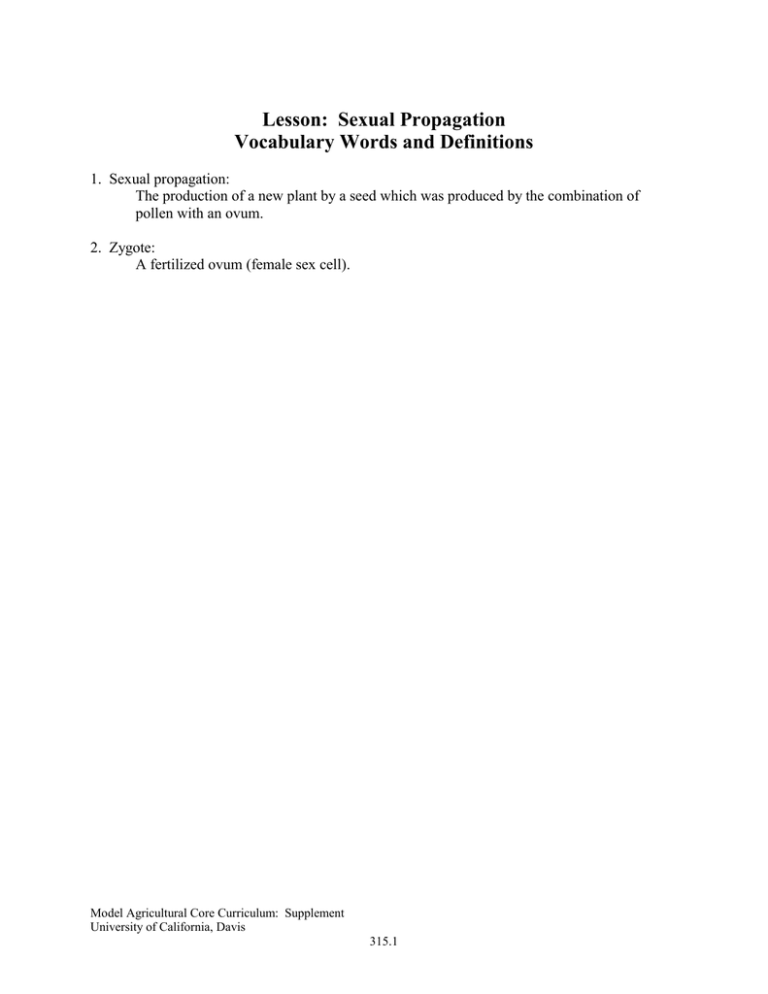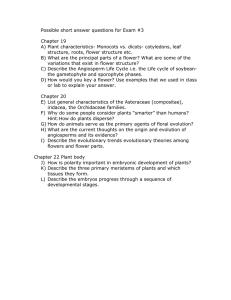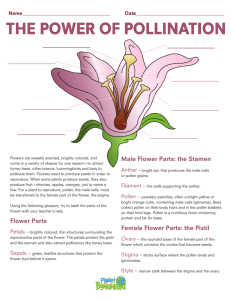Lesson: Sexual Propagation Vocabulary Words and Definitions
advertisement

Lesson: Sexual Propagation Vocabulary Words and Definitions 1. Sexual propagation: The production of a new plant by a seed which was produced by the combination of pollen with an ovum. 2. Zygote: A fertilized ovum (female sex cell). Model Agricultural Core Curriculum: Supplement University of California, Davis 315.1 Name:__________________ Date:___________________ Class:__________________ Title: Flower Dissection Lesson: Plant Parts Laboratory Purpose: There are many different types and classifications of plants that we make use of in agriculture. These plants are broken into their respective categories by their construction and the different parts that make up the flower. In this lab, you will dissect and identify the reproductive parts of the flower. Procedure: Materials: 1. Dissecting microscope or magnifying glass. 2. Scalpel. 3. Poppy flower or another easily dissected blossom. 4. Diagram of flower parts. 5. Labels for flower parts. Sequence of Steps: 1. Using the diagram in the observation section, color the following plant parts the appropriate color. a. Label the sapel and color it green. b. Label the stem and color it light green. c. Label the petals and color them pink. d. Label the filaments and color them dark blue. e. Label the anthers and color them light blue. f. Label the stigma and color it bright red. g. Label the ovary and color it orange. h. Label the ovule and color it brown. i. Label the pollen tube and color it yellow. j. Label the style and color it bright red. 2. Gently separate the flower. Identify the above parts on the flower blossom and label them accordingly using the labels provided by your teacher.. Observations: 1. Label the following diagram by coloring each of the appropriate parts the colors which are specified above. Model Agricultural Core Curriculum: Supplement University of California, Davis 315.2 Model Agricultural Core Curriculum: Supplement University of California, Davis 315.3 Conclusions: 1. Fill in the chart below with the functions of the listed parts and whether the part is part of the male, or female reproductive organs of the flower. Part Function Sepal Petal Pistil Stamen Filament Anther Stigma Style Ovary Pollen Ovule Male/Female/Neither 2. The stamen is made up of the male reproductive parts of the flower. List all of the male flower parts below. 3. The pistil is made of the female reproductive parts of the flower. List the female reproductive flower parts below. 4. What is the difference between a complete and an incomplete flower? 5. What are some of the ways by which pollen gets to the pistil? Model Agricultural Core Curriculum: Supplement University of California, Davis 315.4 6. What do the flowers become after they have been pollinated? Model Agricultural Core Curriculum: Supplement University of California, Davis 315.5 Lesson: Sexual Propagation Bank of Questions 1. Question: Are the plants which are produced from seed exactly the same as the parental plants? Why or why not? Answer: Seeds are made from both of the parents' genetic material. As a result, the daughter plant will have a combination of both of the parents' genes and therefore can not be exactly the same as either of them. 2. Question: List five plants which are propagated sexually. Answer: Possible answers are: corn, wheat, barley, oats, cotton, broccoli, lettuce, sunflower, cannola, tomatoes, spinach, basil, thyme, oregano, and any other plants which are raised from seed. 3. Question: Answer: 4. Question: Answer: How is the pollen placed on the stigma? The pollen may be moved either by wind, insects, birds, or other animals. What is the seeds main function? The seeds main function is to produce a new plant. Model Agricultural Core Curriculum: Supplement University of California, Davis 315.6





